The following conversation took place on May 6, 2016, at Carol Bove’s studio in Red Hook, Brooklyn, and was edited for publication.
Alice Wang: Artists tend to have very sharp senses. For example, I believe Cézanne had the capacity to perceive certain hues and dimensions that other people could not. It enabled him to render in two dimensions the unstable and shifting reality of lived experience. In your practice as a sculptor, you can probably sense certain material and spatial subtleties because you’ve invested so much training in tuning into the dynamics of sculpture. These subtle forces transcend questions of form or beauty—something else is being activated.
Carol Bove: There’s some kind of nonverbal intelligence in the shapes and textures.
AW: This makes me think of the Felix Gonzalez-Torres retrospective you participated in at the Fondation Beyeler. For me, Gonzalez-Torres’s work is almost at a crossroads; it can be framed in a conceptual way or an institutional critique way—but something else is also happening that escapes language. I realized it when you showed—but did not show—his work. You displayed some of the pieces in their packaging.
CB: At the Beyeler, one half of the show I did was to restage a 1991 Felix Gonzalez-Torres show called Every Week There is Something Different. In the downstairs galleries at the Fondation Beyeler, there’s one room that has no windows and is about the same scale as the original Andrea Rosen Gallery. We built an architectural facsimile of Gonzalez-Torres’s historical show, and stored all of the materials for the shows that weren’t on exhibition in the room that you passed through on your way to the exhibition. All the boxes of candies, posters, and strings of beads in the staging area were parts of pieces that we had to refabricate using commercially available and unmanipulated materials.
The show changed once a week, except one week it changed twice. We would move the work that had been on exhibition into the staging area. When you walked through the staging area, you would see the work that was not on exhibit—but it was being exhibited as not exhibited. It had a very different energy. It was as if it was resting, relaxing, because it was not performing. In the exhibition space it was performing, but it hadn’t changed in any way, it had just been moved. It was arranged, but not into a complex shape; it was just put in the corner or made into the shape of a rectangle. I thought it was really exciting to see how subtle physical changes completely changed the works ontologically. You still don’t understand how the material becomes sculpture, even when the process is made completely transparent.
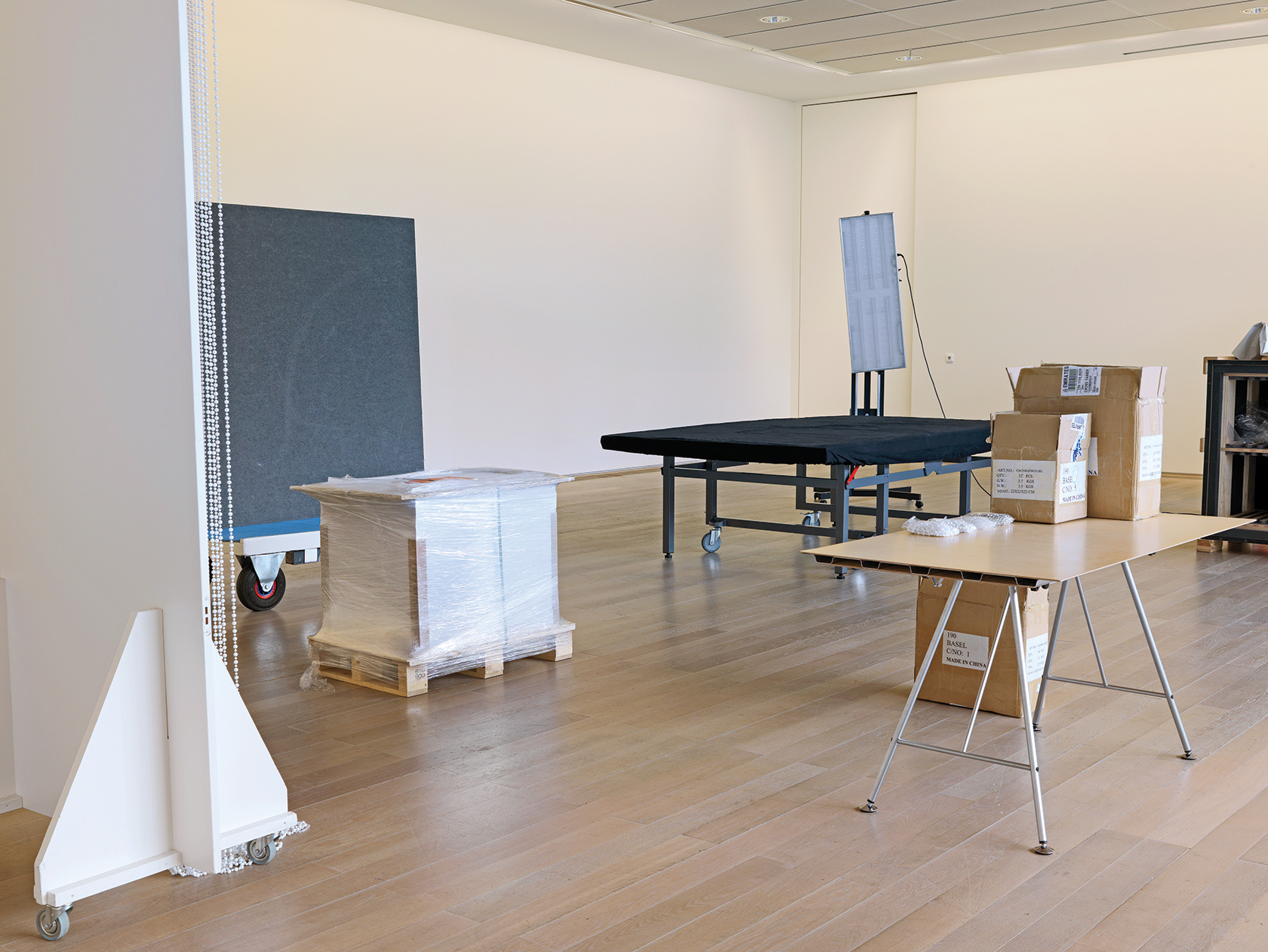
Installation view, Gallery 20 staging area for Every Week There is Something Different reconstruction, as part of Felix Gonzalez-Torres: Specific Objects without Specific Form, curated by Carol Bove. Fondation Beyeler, Basel, Switzerland, July 31–August 29, 2010. © The Felix Gonzalez-Torres Foundation. Courtesy of Andrea Rosen Gallery, New York. Photo: Serge Hasenboehler.
AW: It’s similar to what you said earlier in your studio about unintended illusionism—in the process of illusion making, something else happened.
CB: One of the things that most interested me in doing this project was seeing how Gonzalez-Torres had made arrangements. He famously didn’t have a studio, so I have to imagine that as he was making work he was expecting to see it in the gallery for the first time. So he was thinking about the gallery almost as the muse; it’s the invitation, it’s the situation. The physical gallery space was probably a really compelling formative space/occasion, and the types of relationships he made between objects were very deliberate.
Gonzalez-Torres didn’t invent the solo show that looks like a group show, but he created a very clear template for it. It’s not installation art, but it’s very sensitive to the way it’s installed. There are different types of artworks in the space, and he anticipated that a viewer would have to interact with each of them really differently. It places demands on the viewer, because you can’t just go in and look at everything with the same eyes or the same strategy—you have to use a different interactive strategy with each piece. For example, going into a room with a beaded curtain and interacting with that piece means touching the piece and walking through it. That’s your strategy as a viewer. Then, going up to a candy piece, you have to reset your strategy—whatever social awkwardness you feel about taking candy. Who do you ask if it’s ok? The tension of breaking through that barrier is part of your viewing strategy. Personally, I’m very inhibited about physically interacting with works of art. Grappling with my uneasy feelings around being asked to perform on the work’s terms is part of viewing this type of art for me. That you would actually allow the sculpture to go into your body is totally radical, but then it’s candy, it’s sweet, it’s seductive. There’s a lot of seduction in Gonzalez-Torres’s work—the idea of moving the viewer through the space, suggesting different actions to take. Sometimes he would have a regular photograph and, as the viewer, you would have to say to yourself, “now I’m just going to look at this as if this normal photograph is a normal photograph.” He heightens the artificiality of the situation by making all of these possibilities for the viewer. Ultimately, you’re looking at display itself.
I had seen his work exhibited many times over the years, but I hadn’t seen his sets of work, in other words, all of the works he displayed together in one exhibition considered as a coherent grouping. It was so exciting to see the groupings sequentially, because the pieces related to each other within one hanging, but the hangings also interrelated across the weeks. For example, in one week, everything was on the left of the gallery and in the next week everything was on the right of the gallery. That’s not in the documentation, but it’s so clear in his intention. I see this as an important part of his practice that he was doing but wasn’t talking about. I see these sets as complete statements; they’re not artworks per se but they are something similar. I don’t have a way to talk about what the groupings are. As non-objects, they resist language.
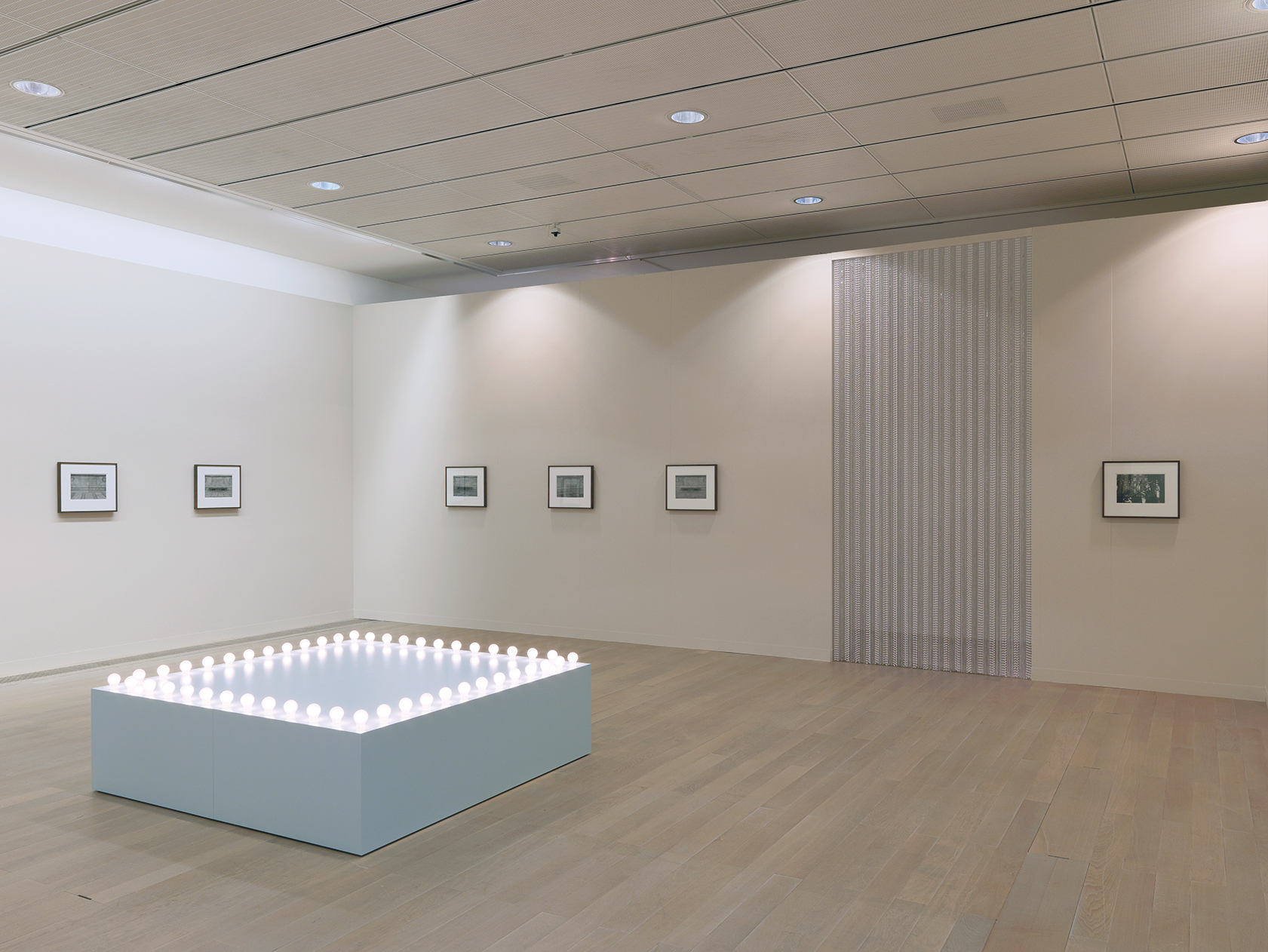
Installation view, Week 3 of Every Week There is Something Different (week of August 1, 2010), restaged as part of Felix Gonzalez-Torres: Specific Objects without Specific Form, curated by Carol Bove. Fondation Beyeler, Basel, Switzerland, July 31–August 29, 2010. Foreground: Felix Gonzalez-Torres, “Untitled” (Go-Go Dancing Platform), 1991. Wood, lightbulbs, acrylic paint and Go-Go dancer in silver lamé bathing suit, sneakers and personal listening device, overall dimensions vary with installation, platform: 21½ × 72 × 72 in. Background: Felix Gonzalez-Torres, “Untitled” (Natural History), 1990. Framed black-and-white photographs; overall dimensions vary with installation, thirteen parts: 16¾ × 20¼ in. each, image; 87⁄16 × 12 in. each. Edition of 3. Background right: Felix Gonzalez-Torres, “Untitled” (Chemo), 1991. Strands of beads and hanging device, dimensions vary with installation. © The Felix Gonzalez-Torres Foundation. Courtesy of Andrea Rosen Gallery, New York. Photo: Serge Hasenboehler
AW: The feeling of a heightened bodily experience seems to be obvious with Gonzalez-Torres’s work, because you have to physically walk through the curtain or eat the candy. But there’s also a strange mind-body trigger when encountering your work, because I can’t touch any of it.
CB: You have to touch it with your imagination.
AW: Yes, it’s a total mind-body experience. I remember seeing the platform you made for The Foamy Saliva of a Horse, at the Arsenale in the 2011 Venice Biennale, and being very conscious of the viewing experience. As I walked around the gigantic plinth, taking in the work from a low vantage point, I had to strain my body in order to run my eyes over the objects. Some scientists believe that we don’t have the cognitive capacity to consciously process 100% of the information we take in. This means that involuntary cognitive processes are happening, and the mind-body can be cultivated to become aware of these subtle cues. You use the phrase psychic energy. It’s not that it’s non-intellectual; rather, as the title of the catalog for your Kunstverein Hamburg show in 2004 suggests, it’s Below Your Mind.
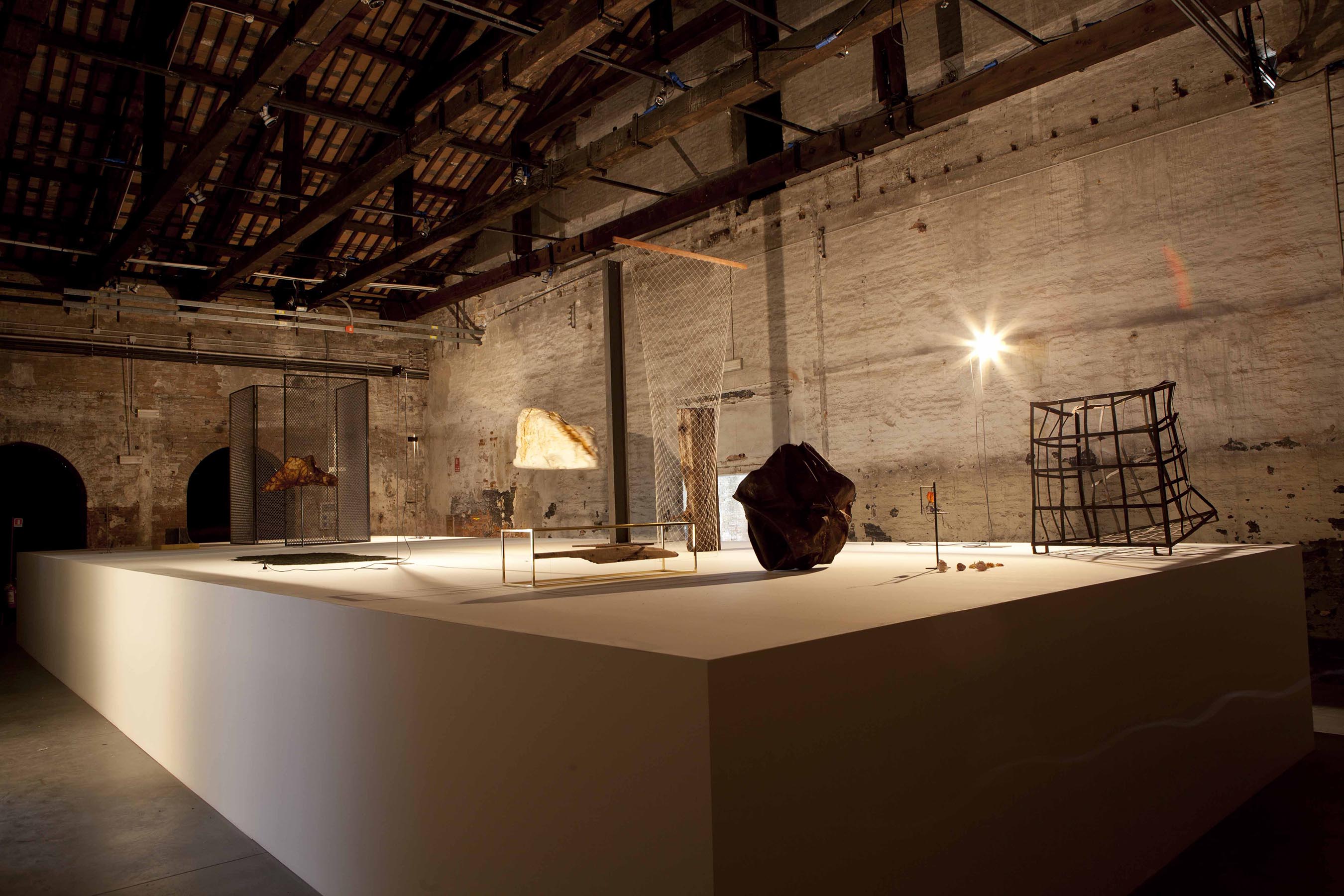
Carol Bove, The Foamy Saliva of a Horse, 2011. Found metal, bronze, driftwood, sea shells, peacock feathers, steel, gold chain, silver chain, foam, Styrofoam. 174 × 600 × 222 in. Installation view, 54th International Art Exhibition, Illuminazioni—Illuminations: la Biennale di Venezia/Venice Biennale, June 4–November 27, 2011. © Carol Bove. Courtesy of the artist, David Zwirner New York/London and Maccarone New York/Los Angeles.
CB: I want to set up these conflicts between your intellect and other types of experience.
AW: I feel that the type of intelligence we are talking about applies not only to art but also to sociopolitical situations, such as diplomacy or even in sports—like boxing. There’s a different order of knowledge at play.
CB: I’ve been trying to find tools to work with the intelligence that I have that’s nonverbal and not to lead with the verbal intelligence. Sensory, social, emotional, pre-objective—there are these other types of intelligences that you have, like pheromone reception, that are sources of information and of intelligence. Your spiritual sense, your survival instinct, and your sense of location, for example, and all these other senses that comprise your total intelligence and outweigh your verbal intelligence. But, it’s also important to try to create bridges so that you can communicate verbally about them.
One thing that I’ve been trying to do along those lines for my work is just to support my free associative thinking, which is a type of thinking that works with images, sensations, and emotions, and is more nonlinear. It’s inhibited by task-based thinking, which is goal-oriented and linear. There are so many things in our culture that support task-oriented thinking. It’s great—I have nothing against it, but, it’s overemphasized.
I was so happy recently to read about all the neurons scientists are finding in your stomach—you have this second brain in your stomach. It makes me think about your “gut reaction,” that expression is based on this physical reality.
AW: Finally, science can prove this thing we all feel and know to be true; it’s not wishy-washy.
CB: Right, it’s not wishy-washy; it’s scientifically based. In Zen meditation, they talk about putting your consciousness in your abdomen. You have a brain there, and you are encouraged to use that visceral brain.
AW: Consciousness is much more
diffused. Seeing the different textures in your work, somehow my mind starts to travel to my toes. It’s not conceptual—or, if it is conceptual, it’s not centered in the brain. Is that possible?
CB: To have a non brain-based conceptual experience…
AW: Focusing one’s consciousness on the gut in Zen meditation—that’s a concept, but it transcends the cerebral. That’s why I tend towards Buddhism, the I Ching, or the Tao Te Ching. These ancient treatises contain concepts, but the way language is used in these texts also seems to produce an altered experience.
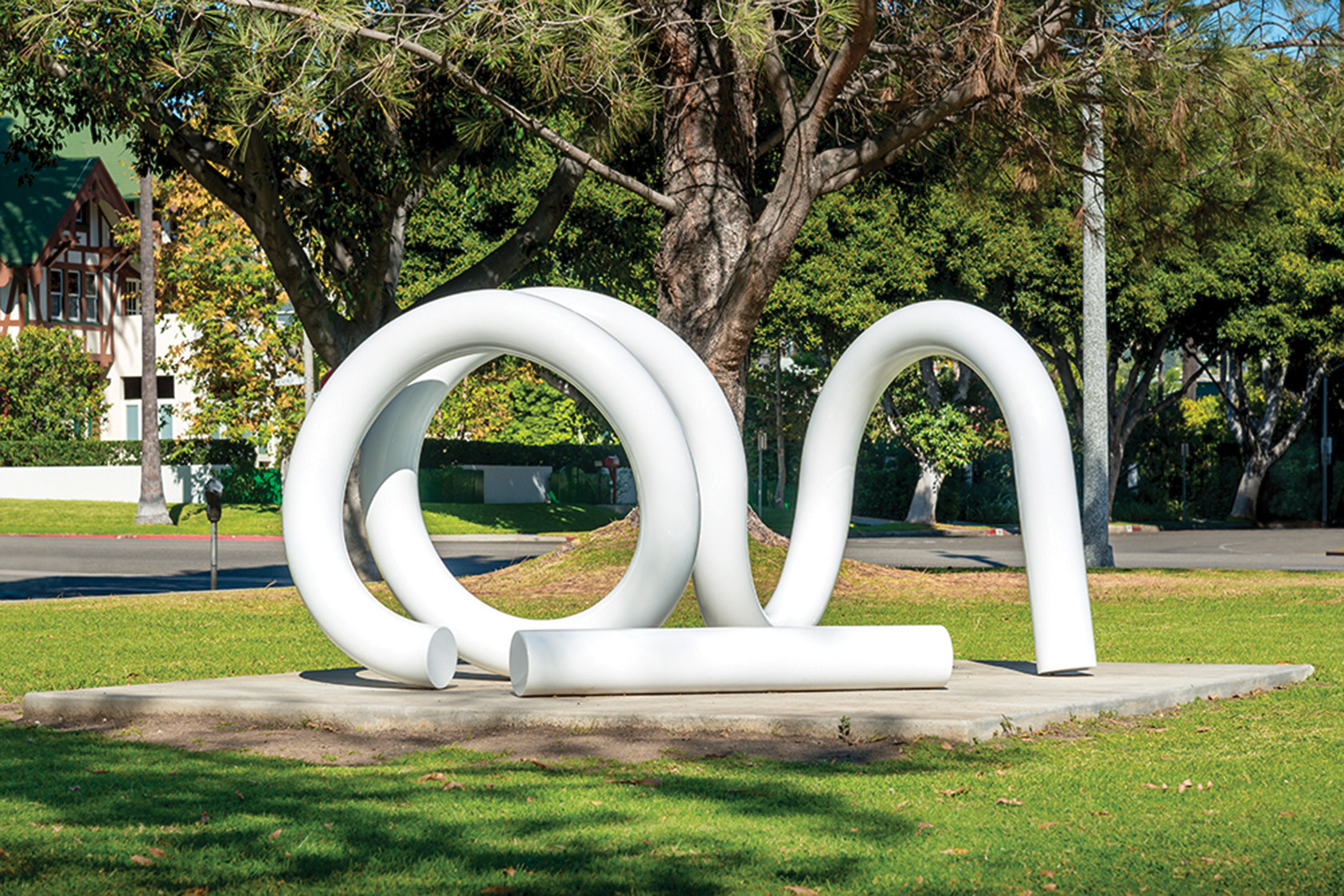
Carol Bove, Io, 2014. Stainless steel and urethane paint. Beverly Gardens Park, Beverly Hills, California. © Carol Bove. Courtesy of the artist. David Zwirner New York/London and Maccarone New York/Los Angeles. Photo: Joshua White.
CB: Right, there is no stable self, and we are constantly being influenced and affected by our environment, biology, and language.
AW: It was through reading your book Below Your Mind that I was able to enter your work through a completely different mindset. You talk about the unconscious impulse we have for reading artworks; it’s almost the default mode for experiencing contemporary art. I find that your work has a conceptual feel and can be read, but it’s not entirely based on the intellect. Yet, it doesn’t end with the phenomenological either, because you’re also working with symbols.
CB: The idea of reading and referentiality has been a concern for me in the last few years because I see how destructive it is, and how much it cheats us from having actual art experiences. There has to be more. But you will read works of art—and you have to accept that your viewer will read works of art. So how can you frustrate reading so that you can have an experience and be open to not immediately understanding it, like being open to a paranormal encounter? In a paranormal experience, you are introduced to a concept that hadn’t existed for you before. It is an intrusion from somewhere else. It’s totally disturbing. A wound in reality. We want the wound to close, and to make the wound close we have to understand it. To understand it, we have to put a concept to it; once we have a concept, the wound can close, and then we can be comfortable again. As a viewer, I think it’s important to cultivate the idea that it’s ok to have the wound in reality, and for that you need a tolerance for discomfort.
AW: It’s like having those wiggly lines slip into the viewers’ consciousness through their peripheral vision.
CB: Something completely nonreferential would be something that’s really unknown. But also, I think there’s a way that an artist could work with signs where the signs never resolve, where the meanings are always ambiguous and inconclusive yet they hold out the promise of a definite meaning. As a viewer, you are left chasing false clues. The chase holds the discursive intellect captive; meanwhile, the rest of your intelligence can interact with the poetic dimensions of the work. These are the tools I’ve been thinking about.
AW: I feel that sometimes an artwork that’s perceived as beautiful can be quickly dismissed; but that aspect of seduction is something you are actively working with. In the press release for your show Plants and Mammals at the Horticultural Society of New York (2008), you wrote:
Flowers are shaped by many forces. They reflect commerce, taste, intellectual labor, fashion, customs, human emotional life. They are indexical with a culture in a given moment. They are the living expression of social forces and social experience. But all of this content remains part of a hidden dimension. Flowers are so lovely and gratuitous, even dismissible. When they are read at all it tends to be for the content of an interpersonal gesture. Like romantic intentions. Or solidarity with the bereaved.
This statement seems to encapsulate your work in a really nice way: it’s not just the surface, but it could be.
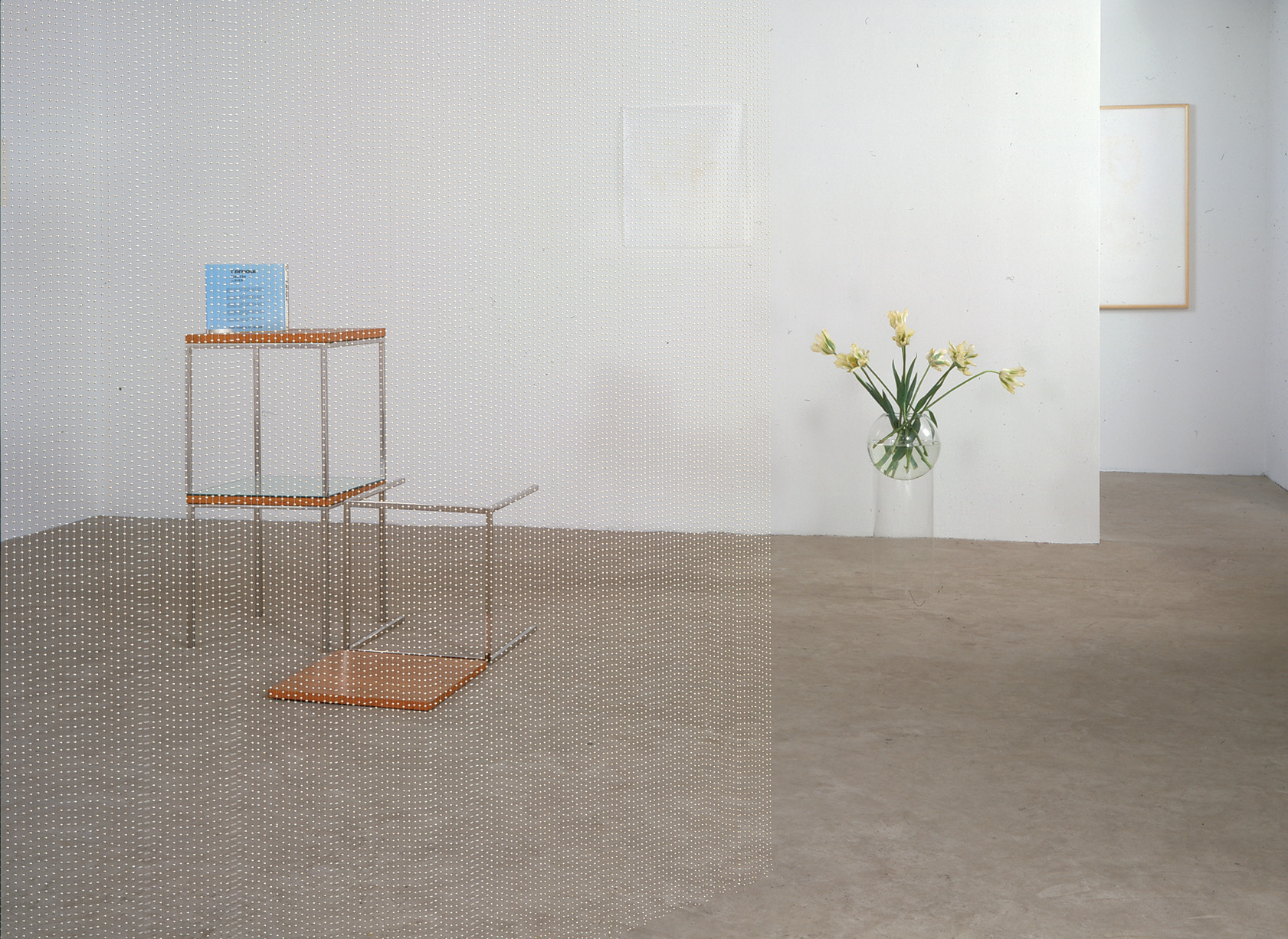
Foreground: Carol Bove, Oriented Plane, 2003. Sterling silver, monofilament and Plexiglass. Left: Carol Bove, The Look of Thought, the Ways of Thought, 2003. Knoll tables, mirror, book. Right: Janine Lariviere, Garden Flowers, by Janine Lariviere, 2003. Flower bulbs, glass and Plexiglas vases and unlimited Xerox edition. Installation view, Experiment in Total Freedom, Team Gallery, May 3–June 21, 2003. © Carol Bove. Courtesy of the artist, David Zwirner New York/London and Maccarone New York/Los Angeles.
CB: It could flicker between being nothing and being full of things—being empty or being full. That idea about flowers is something I’m really conscious of, as with any design object or even with sculpture. A design object manifests ideology. What we were looking at in my studio upstairs, those works could only be made in that studio. The studio is the void that they come into, so they really are the product of the process that they’re developed through, and the process has meaning and intention.
People have this long-standing conflict with the idea of beauty. We don’t trust it because we don’t trust our motives. We are worried we like something because it is agreeable. We’re worried we like it because it appeals to us and not because of some real truth that it’s expressing. Truth is not always so comfortable, and in fact, we know it’s mostly not comfortable. So, it’s natural to be suspicious. Because of this long-standing prejudice against beauty, it seems sexy to me to work with that, since you’re not supposed to do it.
AW: It’s a bit kinky.
CB: Yes.
AW: Flowers, seashells, peacock feathers, driftwood, and junk assemblage—these materials are considered cliché and almost taboo to use in contemporary art. Yet, over the years you’ve developed a sculptural lexicon with these materials.
CB: I think the content of that perversity is part of the hook—that’s the difficulty. As a viewer, you sense the perversity of it, and that’s why it’s ok: it’s ok because it’s perverse. It has invisible barbs. That’s the disagreeable part of the work. And people actually need that in order to interact with art. So first there’s the idea of perversity, which makes interacting with this art object ok, and then there’s hiding the difficulty in a form that’s difficult to perceive. You have to always be creating different ways to assault the viewer, and you have to be very tricky about it. That sounds like a defense for something, and I feel more and more that it’s important not to defend things, or to make things that are indefensible. Something beautiful could maybe, in a way, be indefensible, but also undefended.
AW: There’s a disjuncture in the feeling of your forms and how they become what they are. There’s something at work between what’s happening in the studio and when the objects are manifested on display.
CB: The studio is a mess! That’s the big difference. If you’re making things that are repeatable, it’s craft; if you’re making things that are not repeatable then it’s art. But, you can’t really get skilled at making art because the process is always going to be different each time, and the actual training is more in developing the capacity to recognize when art happens. It’s interesting, the difference between capacity and skill, even though they may be related.
We keep talking about meditation. Say you’re meditating with the idea that if you keep meditating then you’ll get enlightened. If you start meditating in this goal-oriented way, thinking that there are steps along the path, you may never get there. But if you’re more open to the idea that there’s just going to be a flash and something could happen—you don’t know where it’s going to happen and you’re just going to be patient about it—you get to the goal, ironically, by being non-goal oriented. You have to rely on things that come from unexpected places, being flexible and open to insights. I think that’s the type of capacity that you need in art making. Those insights could come when you’re sick or when you’re being your most lazy, where you least expected it—or, in the worst situation. It could be hiding anywhere.
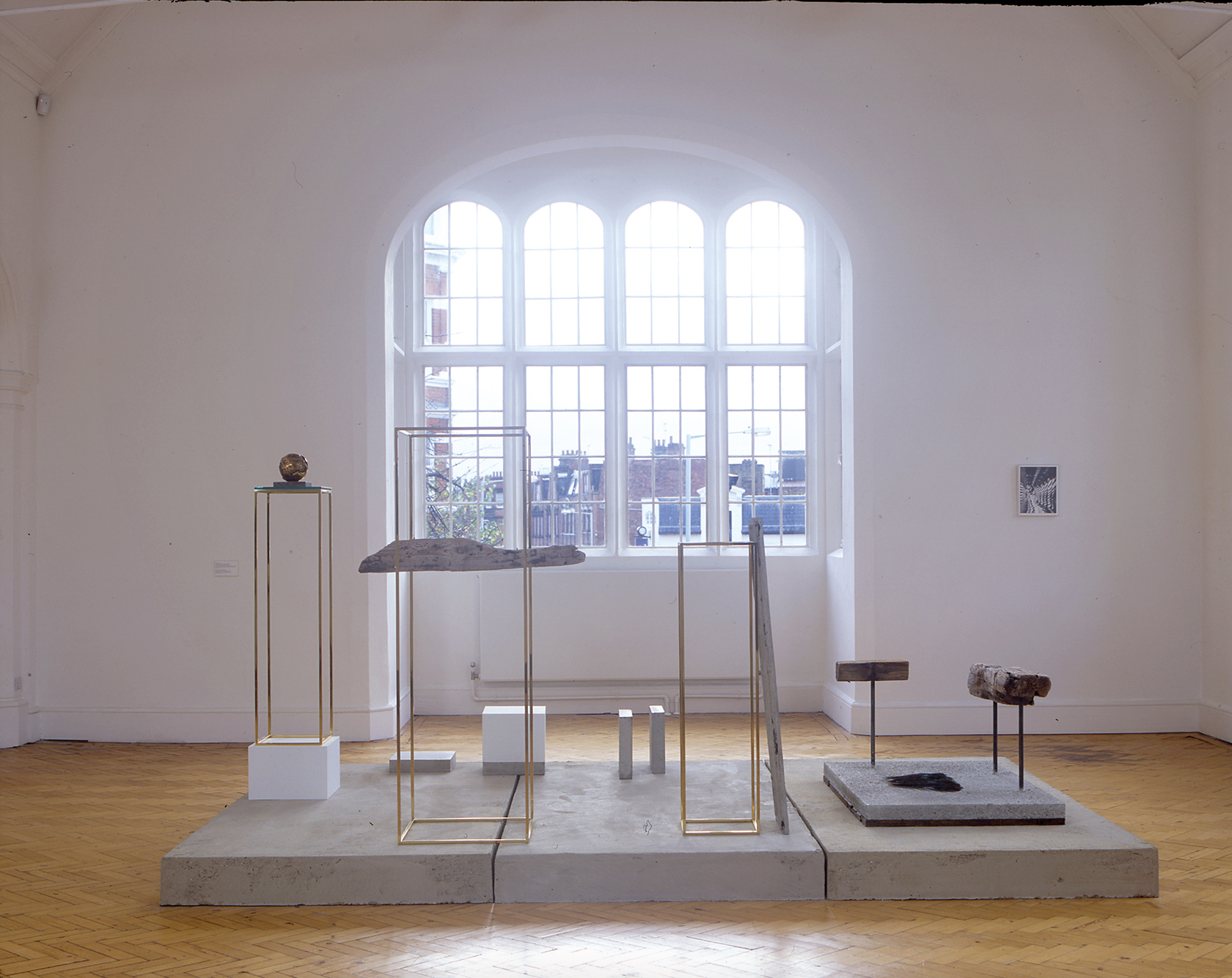
Carol Bove, Setting for A. Pomodoro, 2006. Concrete, bronze, Arnaldo Pomodoro sculpture, driftwood, steel, and wood; 72 × 96 × 144 in. Installation view, Strange Events Permit Themselves the Luxury of Occuring, Camden Arts Centre, December 7, 2007–February 7, 2008. Curated by Steve Claydon. © Carol Bove. Courtesy the artist, David Zwirner New York/London and Maccarone New York/Los Angeles. Photo: Andy Keate.
AW: It goes back to the impulse of reading the object, not letting the object be something unknown, and always trying to categorize it as something recognizable. Eventually it will be recognized—but it’s that moment, that special time period.
CB: Yes, it’s the lifecycle of the object. In the beginning, it’s larval, that’s when it’s interesting. That’s when you don’t know what it is, maybe it’s nothing, maybe it’s terrible. And then people accept it, then it goes to a museum, and then it’s kind of dead—and that’s just the lifecycle.
AW: The manipulation of scale seems to be an important element in your work. The inspiration behind Setting for A. Pomodoro (2006) was based on an encounter you had “being in the Museum of Modern Art, looking down at the sculpture garden from a higher floor, these mini sculptures—[each one] a reduced linguistic unit—[describe] the relationship [between] the miniature and the monumental.”1I wonder if you’ve thought about the function of scale in terms of Robert Smithson’s work, for example, in the distinct experiences of encountering the Spiral Jetty (1970), seeing the photographs or drawings, watching the film, walking on the actual artwork, reading the text, and thinking about the piece. In the essay “The Spiral Jetty,” Smithson wrote:
The scale of the Spiral Jetty tends to fluctuate depending on where the viewer happens to be. Size determines an object, but scale determines art. A crack in the wall if viewed in terms of scale, not size, could be called the Grand Canyon. A room could be made to take on the immensity of the solar system. Scale depends on one’s capacity to be conscious of the actualities of perception. When one refuses to release scale from size, one is left with an object or language that appears to be certain. For me scale operates by uncertainty.2
CB: Was Smithson interested in fractals?
AW: Yes—at least, it seems that way.3
CB: Right, he made fractal forms, but I wasn’t sure that he knew about fractals. I think fractals are interesting. I’m consistently drawn to situations where you sense that objects are detached from scale, where you can see a monumental piece, but you know it was made from a smaller piece. Or, where something looks like a model, but there’s nothing about it that you can particularly identify that’s making it look like a model. Those things can detach the object from its scale and give you a sense of floating freely. When scale seems separable from the object, you see the miniature in the monumental, but you could also see the monumental in the miniature.
AW: Maybe the question of scale is, in a way, going back to the idea of your work being conceptual, but not in the…
CB: not in the tradition of conceptual art coming out of the 1960s.
AW: Right.
CB: Yes, it’s more like conceptual art coming out of Felix Gonzalez-Torres.
AW: Maybe the idea of scale is where your work becomes conceptual—it’s in the process of imagining the fluctuations between the miniature and the monumental in relation to the body.
CB: Yes, that makes sense. Just to bring it back to the idea of a conflict with the visceral experience, you have to introduce the intellectual understanding to resolve the conflict, or to at least have interplay with the conflict. Maybe what we were talking about early on is the idea of how you engage both, or how both are engaged. In Flora’s Garden I (2012), the petrified wood as a material is interesting, because it looks like wood but it’s broken like a stone. You sense it as a stone, but you sense it as wood—you have to negotiate the two. It’s speaking in the language of direct experience, but you have to have more of a cerebral knowledge that conditions it.
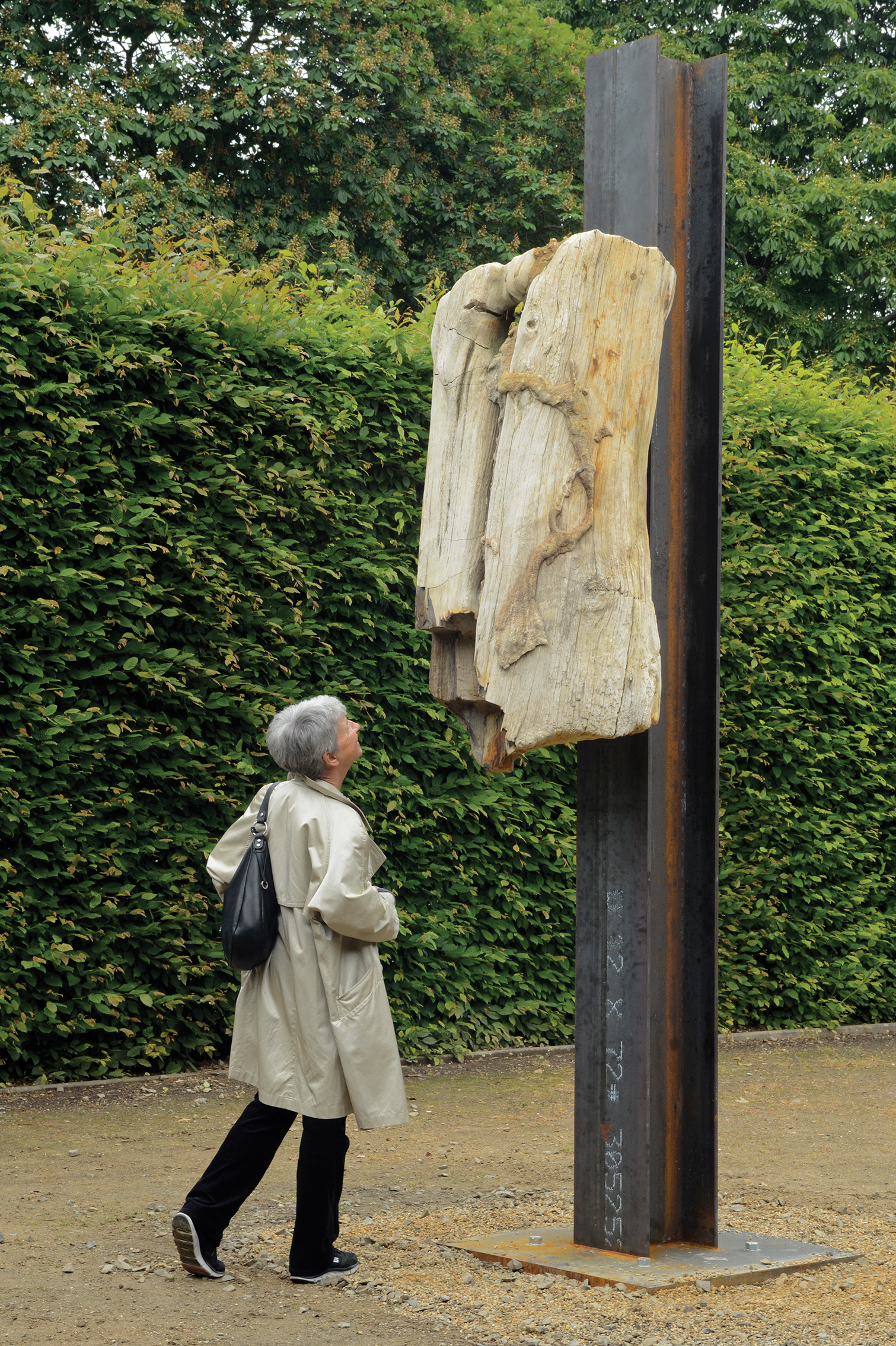
Carol Bove, Flora’s Garden I, 2012. Petrified wood, steel. 144 × 36 × 46 in. Installation view, Carol Bove: Flora’s Garden, dOCUMENTA 13, June 9–September 16, 2012. Curated by Carolyn Christov-Bakargiev. © Carol Bove. Courtesy the artist, David Zwirner New York/London and Maccarone New York/Los Angeles. Photo: Nils Klinger.
AW: Right. The impulse of reading guides the intellect, but the conceptual understanding doesn’t sit well with the phenomenological encounter. Here, our total mind-body intelligence is activated and sets in motion involuntary cognitive processes. The mind-body divide is frustrated in this piece the same way that object and scale or material and form can be separated in your other pieces. Your work seems to exist neither here nor there in some latent imaginary zone.
CB: Yes, it’s a huge motif for me: the thing floating. The heavy thing looks light, the hard thing looks soft, and everything is suspended.
AW: Thinking of suspension, you describe your sculptures as artworks that can be disaggregated, and in that constitution, they have a shifting identity. What is the difference between a hybrid and an aggregate?
CB: A hybrid would be an artwork in which you can identify all the constituent elements, kind of like the genome, and in that frame, the work can be understood. “It’s part Brancusi, but it has a 1980s Gucci look, and Space Invaders. I have the three parts, now I get it.” I don’t know how you would make something that doesn’t do that, but that’s my interest, to almost refer you to some other place, giving false clues so that you can travel with it up to a certain point. But it never really takes you to where it promises, so you then have to start from square one and follow a different clue, which is going to drop you someplace else. Within that, there’s a lot of space for free play and free association, but it doesn’t lead you to the resolution of a riddle. It’s never going to resolve, it’s always going to be a space of free play.
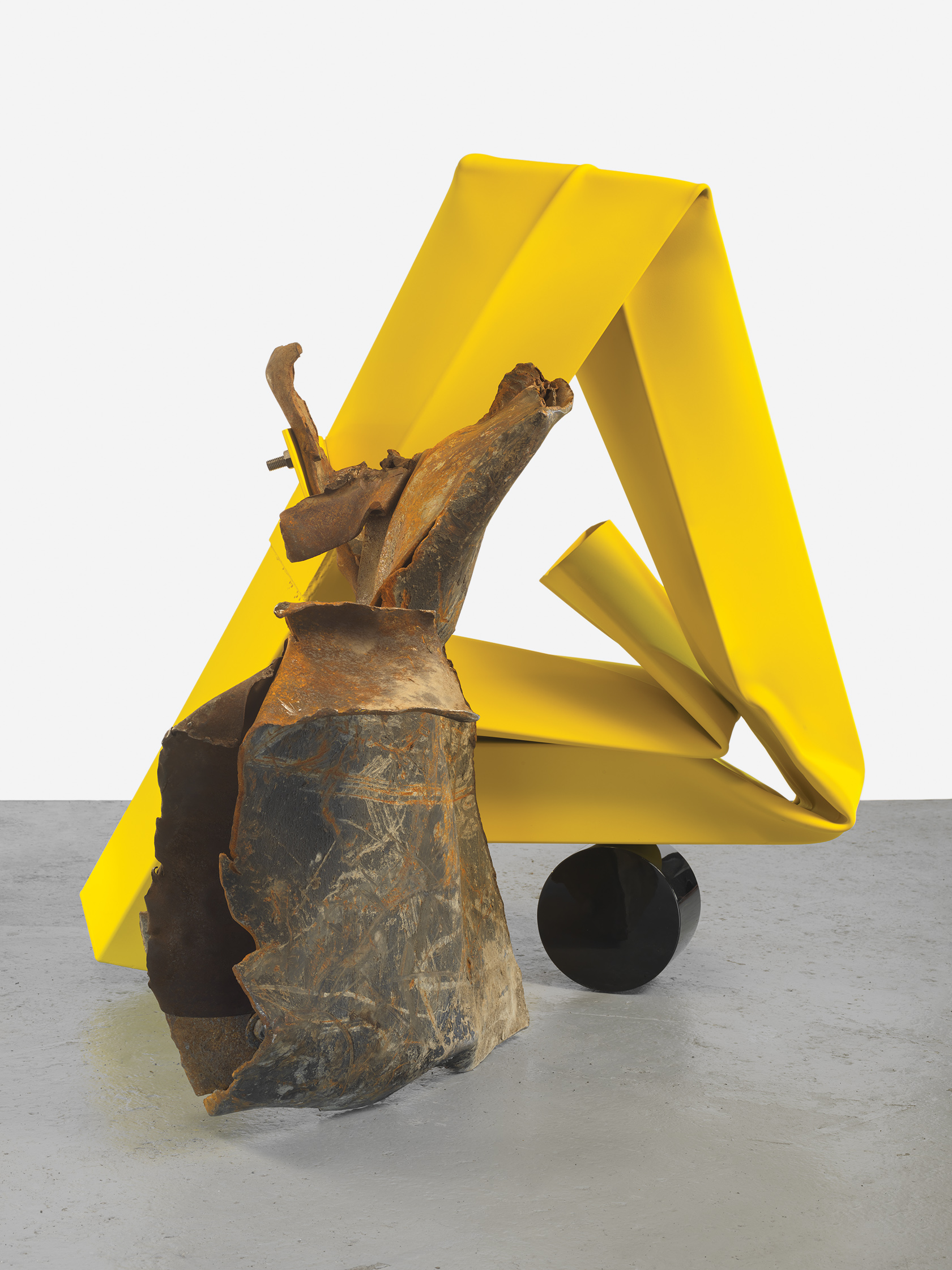
Carol Bove, Mouse Hole, 2016. Found steel, stainless steel, urethane paint, 47 × 46 × 46 in. © Carol Bove. Courtesy the artist, David Zwirner New York/London and Maccarone New York/Los Angeles. Photo: Maris Hutchinson.
Carol Bove lives and works in Brooklyn, NY. Her sculptures, assemblages, paintings and prints are represented in permanent collections around the world including The Museum of Modern Art, NYC; Fonds Régional d’Art Contemporain, Dunkerque, France; The Aishti Foundation, Beirut and The Whitney Museum of American Art, NYC. This spring, she will co-represent Switzerland in the 57th International Art Exhibition at the Venice Biennale.
Alice Wang is an artist based in Los Angeles.
